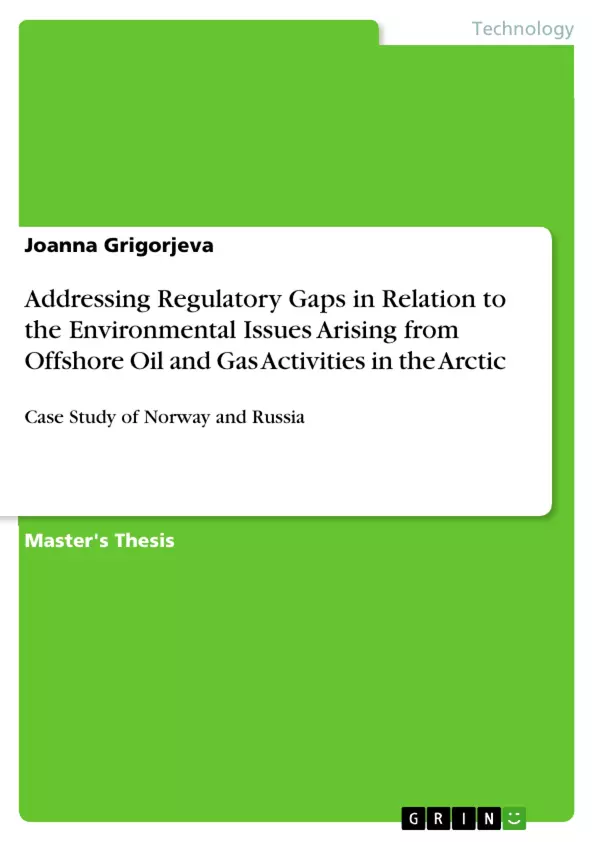Melting of the Arctic ice, caused by global warming and energy security issues, has led Arctic states to prospect further North for new petroleum opportunities. Consequently, the already fragile Arctic marine environment has been further compromised. The Arctic coastal states, under the Ilulissat Declaration, agreed that UNCLOS will provide a legal basis for the regulatory framework in the Arctic, supplemented by Arctic Council soft-law. Consequently, the environmental issues in the Arctic, arising as a result of O&G activities, mainly have to be dealt under the discretion of the Arctic coastal states’ regulations.
By analysing current environmental regulation in the Arctic, the paper aims to discover if the framework can ensure that petroleum activities are carried out in an environmentally safe fashion. To make sure that the Arctic states can address the aforementioned issues, under national legislation, the paper will examine Russia’s and Norway’s petroleum regulations applicable to the Arctic.
In the light of the performed analysis, the paper will propose to address the regulatory gaps created as a result of environmental issues arising from petroleum activities in the Arctic under the Arctic Framework Treaty. To address topical issues at the sub-regional level, an ecosystem-based management plan will be analysed, and suggesting its implementation on the Russian continental shelf.
Inhaltsverzeichnis (Table of Contents)
- Introduction
- The Arctic: A Fragile Ecosystem
- The Arctic Environment
- Climate Change and its Impact on the Arctic
- The Importance of the Arctic
- The Legal Framework for Oil and Gas Activities in the Arctic
- UNCLOS and its Role in the Arctic
- The Arctic Council and its Soft-Law Instruments
- The Ilulissat Declaration
- Environmental Regulation of Oil and Gas Activities in the Arctic
- International Environmental Law
- National Environmental Regulation in the Arctic
- Norway
- Russia
- Addressing Regulatory Gaps in Relation to Environmental Issues Arising from Offshore Oil and Gas Activities in the Arctic
- The Arctic Framework Treaty
- Ecosystem-Based Management in the Arctic
- Implementation of Ecosystem-Based Management on the Russian Continental Shelf
- Conclusion
Zielsetzung und Themenschwerpunkte (Objectives and Key Themes)
This paper examines the environmental regulation of oil and gas activities in the Arctic, focusing on the regulatory gaps that exist in the current legal framework. It aims to analyze the effectiveness of existing international and national regulations in ensuring environmentally safe oil and gas exploration and production in the Arctic. The paper will specifically examine the case studies of Norway and Russia to identify key challenges and propose potential solutions.
- The impact of climate change on the Arctic environment
- The legal framework for oil and gas activities in the Arctic, including UNCLOS, the Arctic Council, and national regulations
- The effectiveness of existing environmental regulations in mitigating the risks associated with oil and gas activities in the Arctic
- The need for a comprehensive Arctic Framework Treaty to address regulatory gaps
- The potential of ecosystem-based management as a tool for sustainable oil and gas development in the Arctic
Zusammenfassung der Kapitel (Chapter Summaries)
The introduction sets the stage for the research by outlining the importance of the Arctic, the environmental challenges it faces, and the growing interest in oil and gas exploration in the region.
The second chapter provides an overview of the Arctic environment, its unique characteristics, and the impact of climate change on the region. It discusses the ecological and economic significance of the Arctic and the need for its protection.
The third chapter examines the legal framework governing oil and gas activities in the Arctic, focusing on the role of UNCLOS, the Arctic Council, and the Ilulissat Declaration. It explores the challenges of balancing economic development with environmental protection in the region.
The fourth chapter analyzes the environmental regulation of oil and gas activities in the Arctic, including both international and national frameworks. It examines the strengths and weaknesses of the existing regulatory regime and highlights key areas for improvement.
The fifth chapter investigates the regulatory gaps that exist in the current legal framework and proposes potential solutions, including the development of an Arctic Framework Treaty and the implementation of ecosystem-based management on the Russian continental shelf.
Schlüsselwörter (Keywords)
Arctic, oil and gas, environmental regulation, UNCLOS, Arctic Council, Ilulissat Declaration, climate change, ecosystem-based management, regulatory gaps, Arctic Framework Treaty, Norway, Russia.
- Quote paper
- Joanna Grigorjeva (Author), 2014, Addressing Regulatory Gaps in Relation to the Environmental Issues Arising from Offshore Oil and Gas Activities in the Arctic, Munich, GRIN Verlag, https://www.grin.com/document/337756



